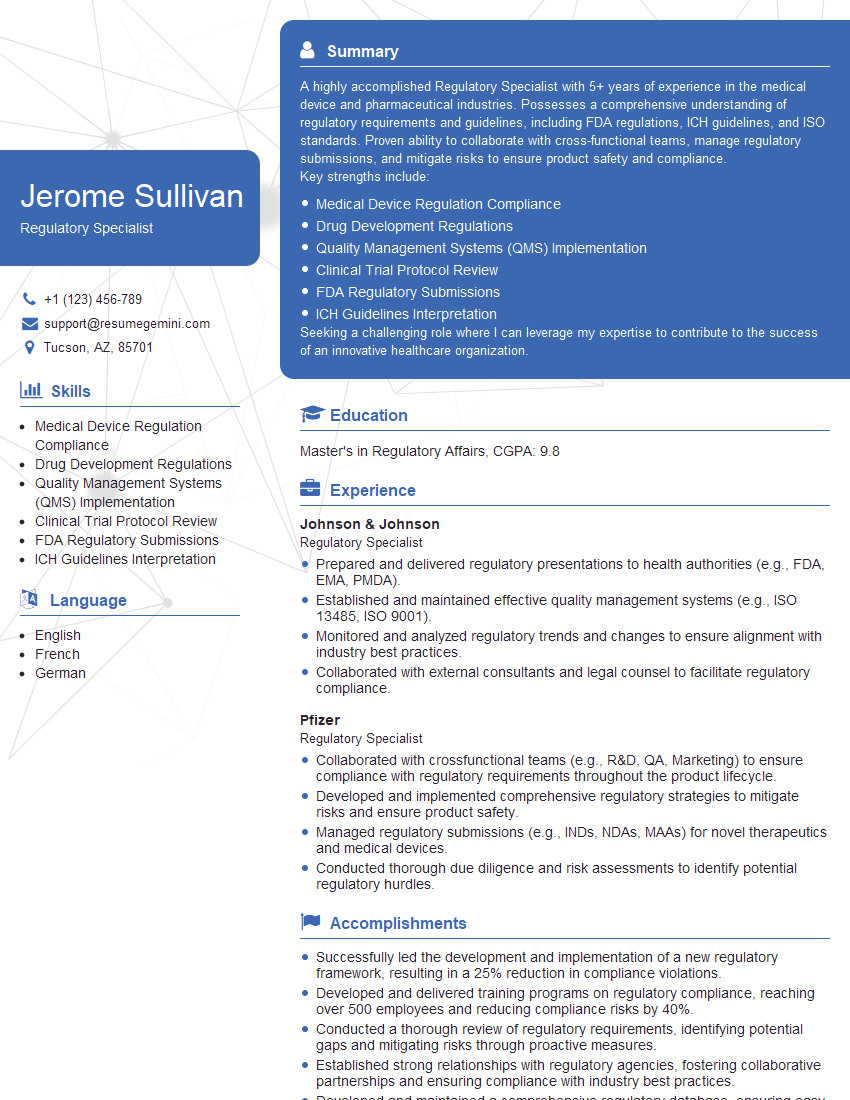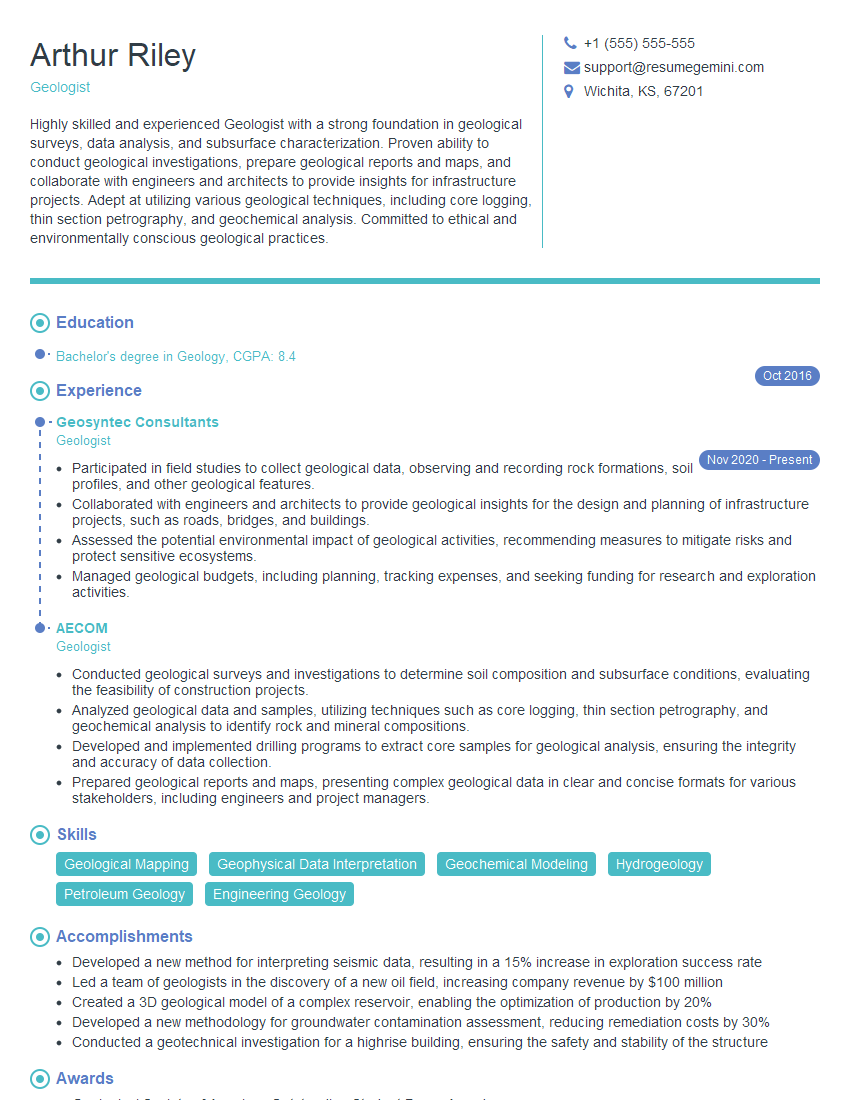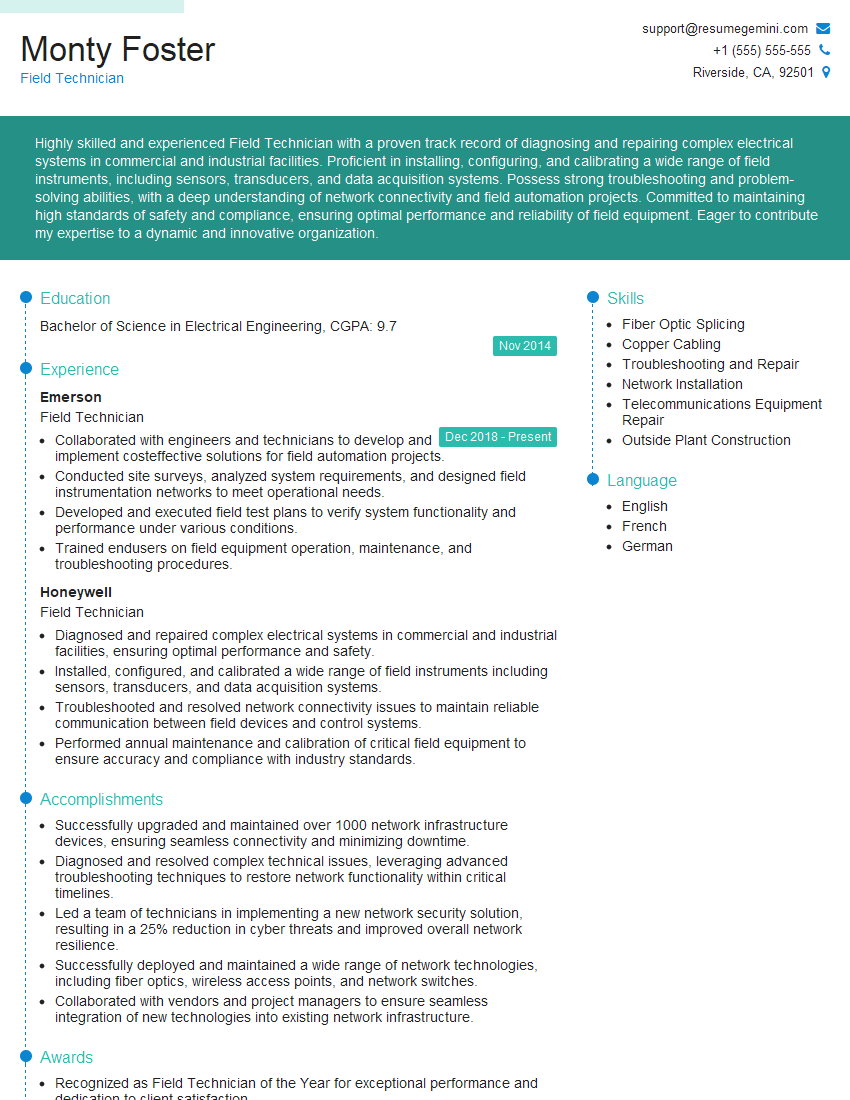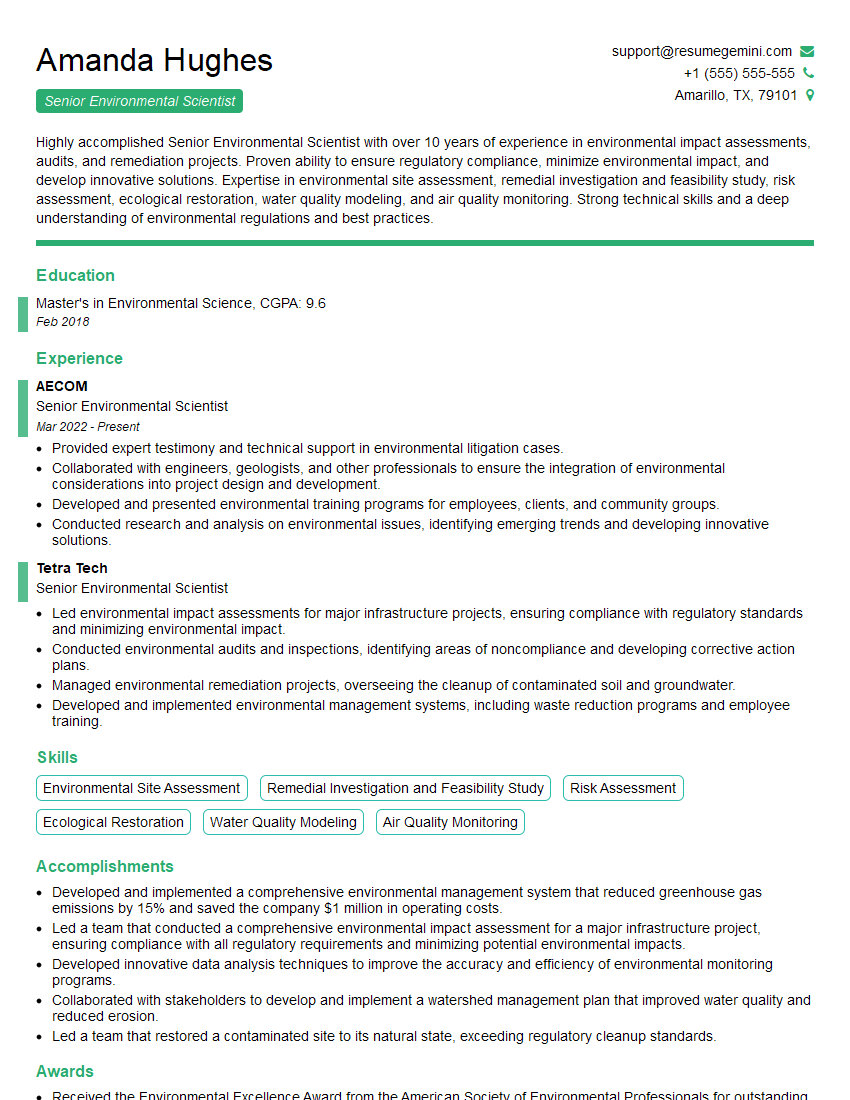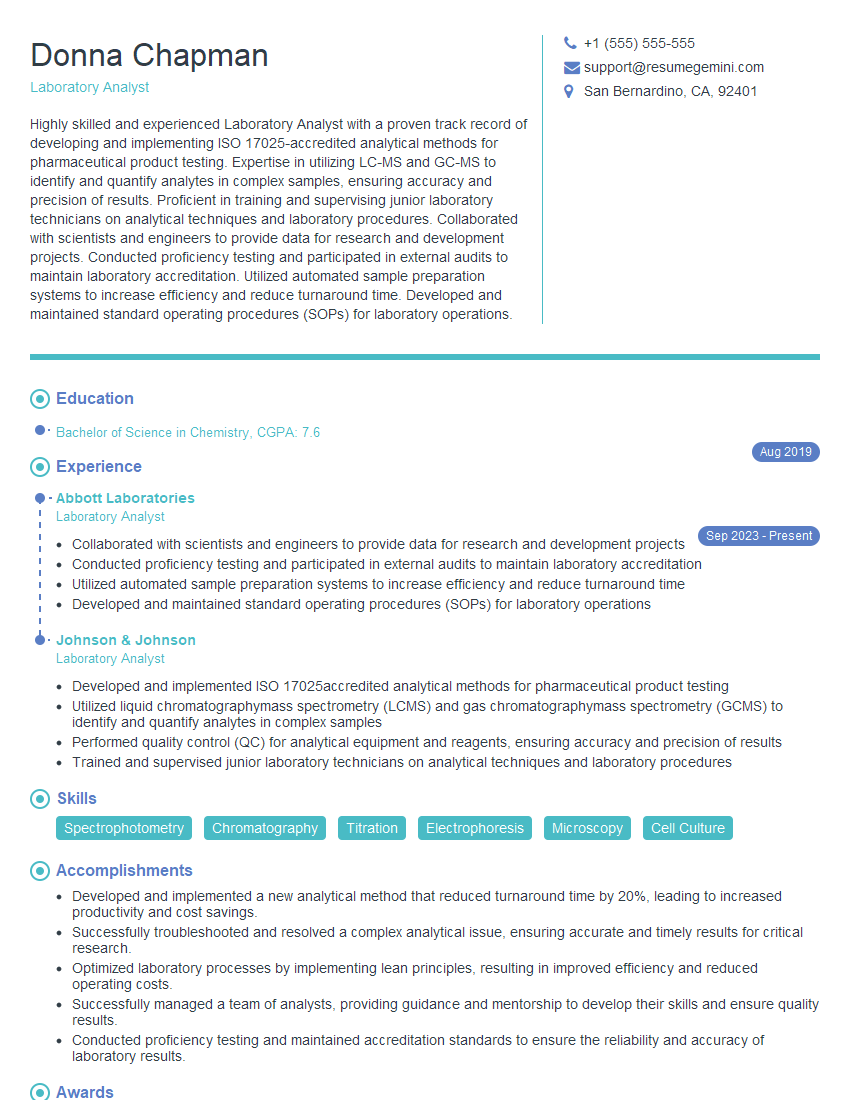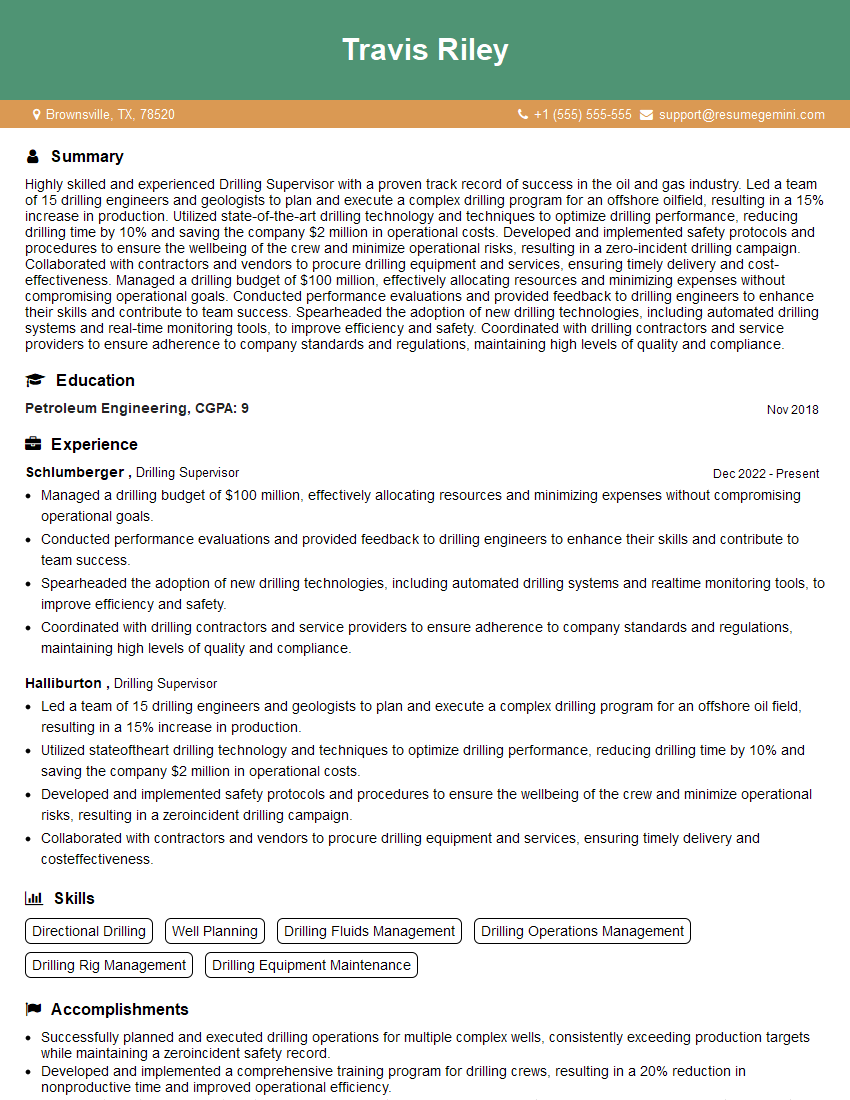Are you ready to stand out in your next interview? Understanding and preparing for Soil and Groundwater Sampling and Analysis interview questions is a game-changer. In this blog, we’ve compiled key questions and expert advice to help you showcase your skills with confidence and precision. Let’s get started on your journey to acing the interview.
Questions Asked in Soil and Groundwater Sampling and Analysis Interview
Q 1. Describe the different types of soil sampling methods and when each is appropriate.
Soil sampling methods are chosen based on the project’s objectives and the site’s characteristics. Think of it like choosing the right tool for the job – a screwdriver for screws, a hammer for nails. Here are some common methods:
- Auger sampling: A hollow auger is rotated into the ground, extracting a continuous soil core. This is ideal for relatively undisturbed soil profiles and obtaining samples at specific depths. Imagine it like a giant corkscrew.
- Hand-held probes: These are simple, inexpensive tools used for shallow sampling. They’re perfect for quick assessments or reconnaissance surveys, like checking for surface contamination.
- Split-spoon sampling: A split-barrel sampler is driven into the ground, retrieving a disturbed soil sample. This is a standard method for geotechnical investigations and is used for soil characterization.
- Shelby tube sampling: This method uses a thin-walled tube to extract relatively undisturbed soil samples. It’s preferred when detailed soil analysis is needed, like determining soil strength or the presence of sensitive contaminants.
- Geoprobe sampling: This technique uses a direct-push method to obtain samples without drilling. It’s faster and quieter than traditional drilling methods, making it suitable for urban environments or sensitive areas. Imagine it as a minimally invasive way of soil sampling.
The choice depends on factors such as depth, soil type, required sample quality (disturbed or undisturbed), and project budget. For instance, a large-scale environmental remediation project might necessitate the use of geoprobe or Shelby tube sampling for accurate contaminant analysis, while a preliminary site assessment might only require hand probes.
Q 2. Explain the process of groundwater well installation and development.
Groundwater well installation and development is a multi-step process crucial for obtaining representative groundwater samples. Think of it as building a specialized water fountain that only draws from a specific depth.
- Site Selection and Investigation: The location must be carefully chosen, considering factors like hydrogeology, proximity to potential contamination sources, and accessibility.
- Drilling: A drilling rig is used to create the well bore. The method used (e.g., air rotary, mud rotary, direct push) depends on the subsurface conditions.
- Well Construction: A well casing (a protective pipe) is installed to prevent collapse and contamination. A screen is typically placed within the casing in the aquifer to allow water inflow. Gravel pack is frequently added around the screen to improve water flow.
- Well Development: This is critical. It involves purging the well of drilling fluids and other contaminants by pumping and bailing out the water until the water quality stabilizes. This ensures that the initial sample collected is representative of the aquifer water, not just drilling fluids.
- Well Disinfection: The well is disinfected to prevent microbial growth.
- Wellhead Sealing: The wellhead is sealed to prevent surface contamination from entering the well.
Proper well construction and development are essential for obtaining accurate and reliable groundwater data. A poorly developed well might yield inaccurate results, leading to flawed conclusions and potentially inappropriate remediation actions. For example, failure to properly purge the well could lead to an elevated concentration of drilling fluids in the sample, misleading the assessment of actual groundwater contamination.
Q 3. What are the common methods for groundwater sampling and what are their limitations?
Several methods exist for groundwater sampling, each with its own strengths and limitations:
- Bailing: A simple method using a bucket to remove water. It’s suitable for shallow wells with low yield but can introduce contamination and is not recommended for monitoring due to its disruptive nature.
- Pumping: A more commonly used method involving a submersible pump. It’s efficient for larger wells, but requires careful management to avoid well damage or aeration. Aeration can alter the chemistry of the sample.
- Peristaltic pumping: This uses tubing to gently extract water and minimizes aeration or sample contamination. It’s a good choice for volatile organic compounds (VOCs) sampling.
- Low-flow purging: This involves slowly pumping groundwater to minimize disturbance and better represent the aquifer’s in-situ conditions. This is a preferred method for reducing well disturbance and more accurately representing the groundwater quality.
Limitations include the possibility of cross-contamination, the introduction of air, and the potential for inaccurate representation of groundwater conditions if improper purging techniques are used. For example, vigorous pumping could alter the groundwater chemistry by introducing dissolved oxygen or disturbing sediment layers.
Q 4. How do you ensure the chain of custody is maintained during sample collection and transportation?
Maintaining chain of custody is crucial to ensure the integrity and admissibility of soil and groundwater samples in legal or regulatory contexts. It documents the handling and transfer of samples from collection to analysis. It’s like a detailed travel log for your samples.
Here’s how to maintain it:
- Unique Sample Identification: Assign a unique ID to each sample at the time of collection.
- Detailed Documentation: Record all information about the sample, including the date, time, location, sampler’s name, and any relevant observations.
- Signed Chain of Custody Forms: Use chain-of-custody forms that track every transfer of samples between individuals, and all sign and date it. These forms ensure the samples remain accounted for, providing an audit trail.
- Secure Sample Transportation: Samples are transported in tamper-evident containers and transported in temperature-controlled environments when necessary. Secure storage before analysis is also vital.
- Sample Sealing and Security: Seal sample containers properly to prevent tampering. Use seals that clearly indicate any breach.
Breaches in the chain of custody compromise the sample’s integrity and can lead to challenges in using the data for legal or regulatory purposes. Imagine finding a package missing its security seal – you would question its contents’ integrity, right? The same principle applies to sample integrity.
Q 5. What are the key quality assurance/quality control (QA/QC) procedures for soil and groundwater sampling?
QA/QC procedures are essential to ensure the accuracy, reliability, and validity of soil and groundwater data. It’s all about minimizing error and making sure your data is trustworthy.
- Field Blanks: These are uncontaminated samples processed along with the field samples to detect contamination during collection and handling.
- Trip Blanks: These are uncontaminated samples transported with the field samples to identify any contamination during transportation.
- Equipment Rinsates: Sampling equipment is thoroughly rinsed between sample collection to minimize cross-contamination.
- Duplicate Samples: Collecting duplicate samples allows for comparison and helps identify inconsistencies in sampling or laboratory analysis.
- Laboratory QC Samples: Laboratories use their own QC samples – spikes, matrix spikes, and duplicates – to monitor their analytical procedures.
- Data Validation: All collected data undergoes thorough validation checks to identify anomalies and outliers before being used for interpretation.
These checks help to identify and correct errors, leading to more reliable results. For instance, a high value in a field blank might indicate contamination during the sampling procedure.
Q 6. Describe the different types of soil and groundwater contaminants and their potential health effects.
Soil and groundwater can be contaminated by a wide range of substances, each with potentially severe health effects. Here are some examples:
- Petroleum hydrocarbons (PHCs): These can cause respiratory problems, skin irritation, and even cancer. Think oil spills or leaking underground storage tanks.
- Volatile organic compounds (VOCs): These evaporate easily and can cause neurological damage, liver and kidney problems, and cancer. Common examples include trichloroethylene (TCE) and benzene.
- Heavy metals (e.g., lead, arsenic, mercury): These can accumulate in the body, causing a range of health problems including neurological damage, developmental issues, and cancer.
- Pesticides and herbicides: Exposure can lead to various health effects, including endocrine disruption, reproductive problems, and neurological disorders.
- Radionuclides: These radioactive substances can cause various health problems, including cancer and genetic mutations. These can be natural or from human activities like nuclear accidents or improper waste disposal.
The specific health effects depend on the contaminant, the concentration, the route of exposure (e.g., inhalation, ingestion, dermal contact), and individual factors such as age and health status. It is crucial to have appropriate exposure standards and monitoring to mitigate these effects.
Q 7. What are the relevant regulatory standards and guidelines for soil and groundwater sampling and analysis?
Regulatory standards and guidelines for soil and groundwater sampling and analysis vary by location (country, state, region). However, there are common themes. It is crucial to consult the relevant standards for the specific area.
Examples of relevant organizations and standards include:
- United States Environmental Protection Agency (USEPA): Sets national standards for numerous contaminants and provides guidance on sampling and analytical methods. The USEPA’s Method 8260B is a commonly used method for the analysis of volatile organic compounds (VOCs).
- National Environmental Methods Index (NEMI): Provides a comprehensive database of approved environmental analytical methods.
- American Society for Testing and Materials (ASTM): Develops and publishes standards for various materials, including soil and water. ASTM standards help ensure uniformity in methods and reporting.
- State and Local Regulations: Many regions have their own regulations that may be stricter than federal guidelines. Always consult these local standards.
Compliance with these standards is essential for proper regulatory reporting, risk assessment and remediation. Failure to comply can lead to penalties and legal actions.
Q 8. How do you interpret soil and groundwater analytical data?
Interpreting soil and groundwater analytical data involves a multi-step process that goes beyond simply looking at the numbers. It requires understanding the context of the data, including the sampling methodology, the site’s history, and the regulatory requirements. First, we verify the data’s quality by checking for outliers and inconsistencies. This often involves comparing results against laboratory blanks and field duplicates to assess accuracy and precision. Then, we compare the measured concentrations to relevant regulatory limits or background levels to determine if contamination exists. For example, if we find arsenic levels exceeding the EPA’s Maximum Contaminant Level (MCL), it indicates potential contamination requiring further investigation. Finally, we analyze the spatial distribution of contaminants, identifying potential sources and pathways of contamination. This spatial analysis, often using GIS software, helps us understand the extent of the problem and inform remediation strategies. We might visualize contaminant plumes using contour maps to show the spread of pollution. The interpretation is crucial for decision-making regarding site cleanup and risk assessment.
Q 9. Explain the process of developing a soil and groundwater sampling plan.
Developing a robust soil and groundwater sampling plan is critical for obtaining reliable data. It begins with a thorough site characterization, involving a review of historical data, site maps, and existing information on potential contaminants. Next, we define the objectives of the sampling program; are we assessing current contamination, delineating the extent of a known plume, or monitoring remediation efforts? Based on this, we determine the appropriate sampling locations. This might involve a grid pattern for comprehensive coverage or a focused approach around suspected sources of contamination. The number of samples is calculated based on statistical considerations, ensuring sufficient data to draw meaningful conclusions. We also select the appropriate sampling methods (e.g., soil borings, direct push, monitoring wells) and depths depending on the target contaminants and the hydrogeological setting. Finally, the plan details chain-of-custody procedures, sample preservation techniques, and laboratory analytical methods to maintain data integrity. Imagine planning a treasure hunt; a well-defined plan ensures you find the ‘treasure’ (contaminant information) efficiently and accurately.
Q 10. How do you identify and mitigate potential sampling biases?
Sampling biases can significantly affect the reliability of results. One common bias is the ‘well-location bias’, where monitoring wells are not strategically placed to capture the full extent of contamination. To mitigate this, we use statistically sound sampling designs and GIS-based analyses to optimize well placement. Another bias arises from improper sample handling. For instance, cross-contamination can occur if equipment is not properly cleaned between samples. We address this through rigorous decontamination procedures, using separate equipment for different sampling locations and employing appropriate cleaning solutions. Lastly, ‘sampling depth bias’ can occur if the sampling depth doesn’t reach the target contaminant zone. We mitigate this through thorough site investigation and careful consideration of subsurface geology and hydrogeology when determining sampling depths. Regular quality control checks, including field blanks and duplicates, further help identify and quantify any biases present in the data.
Q 11. What are the safety procedures to follow during soil and groundwater sampling?
Safety is paramount during soil and groundwater sampling. Before commencing any fieldwork, a thorough site-specific safety plan must be developed and reviewed by all personnel. This plan includes identifying and mitigating potential hazards like confined spaces, hazardous materials, and heavy equipment. Appropriate personal protective equipment (PPE), including gloves, safety glasses, respirators, and hard hats, must be worn at all times. Emergency response procedures should be established, with readily available communication devices and designated emergency contact numbers. Furthermore, proper training on safe handling of equipment and chemicals is mandatory. All personnel must be aware of the potential health hazards associated with the specific contaminants being investigated. In one project, we encountered unexpectedly high levels of hydrogen sulfide, necessitating the use of specialized respirators and stringent safety protocols. Regular safety meetings and toolbox talks reinforce the importance of safe practices.
Q 12. Explain the different types of analytical methods used for soil and groundwater analysis.
Analytical methods for soil and groundwater vary depending on the target analytes. For inorganic contaminants like metals (e.g., lead, arsenic), Inductively Coupled Plasma Mass Spectrometry (ICP-MS) or Atomic Absorption Spectroscopy (AAS) are commonly used. These techniques provide high sensitivity and accuracy. For organic contaminants such as volatile organic compounds (VOCs) and semi-volatile organic compounds (SVOCs), methods like Gas Chromatography-Mass Spectrometry (GC-MS) and High-Performance Liquid Chromatography (HPLC) are employed. These methods are chosen based on the specific characteristics of the target compounds. For example, GC-MS is excellent for volatile compounds, while HPLC is suitable for less volatile, polar compounds. Microbiological analyses may also be required, using techniques like plate counts or molecular methods to detect specific bacteria or pathogens. The selection of analytical methods is guided by the project objectives, the nature of potential contaminants, and the regulatory requirements. Method selection significantly influences the accuracy and the overall cost of the project.
Q 13. How do you handle non-detect results in soil and groundwater data?
Non-detect (ND) results, indicating analyte concentrations below the method detection limit (MDL), require careful handling. They are not simply treated as zeros. Instead, we report them as ‘ND’ with the associated MDL. Statistical methods that account for left-censored data (ND values) are employed during data analysis. For example, we might use non-parametric methods like the Mann-Whitney U test instead of t-tests, which assume normally distributed data. We may also use censored data regression models that explicitly account for the ND values. Additionally, the reporting of ND results must be consistent with regulatory requirements. It’s crucial to understand that an ND result does not necessarily mean the absence of a contaminant, only that its concentration is below the detectable level of the applied method. Therefore, the use of more sensitive analytical methods might be considered if further investigation is required.
Q 14. Describe your experience with different types of sampling equipment.
My experience encompasses a wide range of sampling equipment. For groundwater sampling, I’ve extensively used submersible pumps for collecting representative samples from monitoring wells, ensuring that the collected water accurately reflects the groundwater quality. For soil sampling, I’ve employed various techniques including hand augers for shallow samples, hollow-stem augers for deeper soil cores, and direct-push technology for rapid and cost-effective sampling. Direct-push methods are especially useful for site investigations requiring many samples, like assessing the lateral extent of contamination. I’m also experienced with specialized equipment like Geoprobe rigs which combine direct push with the ability to collect split-spoon samples for both soil and groundwater. The selection of equipment is always driven by site-specific conditions, the depth of the target, and the type of sample required. Regular maintenance and calibration of equipment are crucial to ensure accurate and reliable data acquisition. My proficiency extends to the use of various types of sample containers, ensuring appropriate preservation and transportation of samples to the laboratory.
Q 15. What are the limitations of using grab samples for groundwater analysis?
Grab samples, while convenient and quick, offer a snapshot of groundwater conditions at a specific point in time and space. Their primary limitation lies in their inability to represent the true heterogeneity of groundwater quality. Imagine trying to understand the temperature of a swimming pool by only measuring the temperature at one spot – you might get a reading, but it wouldn’t represent the whole pool accurately. Similarly, grab samples may miss localized plumes of contamination or variations in contaminant concentration due to natural processes like diffusion or advection. Furthermore, they don’t provide information on the vertical distribution of contaminants within the aquifer. This is particularly problematic when dealing with dense non-aqueous phase liquids (DNAPLs), which tend to sink and accumulate in specific zones. For a more comprehensive understanding of groundwater quality, techniques like purging and sampling from dedicated monitoring wells with a peristaltic pump, providing a representative, composite sample are preferred.
Career Expert Tips:
- Ace those interviews! Prepare effectively by reviewing the Top 50 Most Common Interview Questions on ResumeGemini.
- Navigate your job search with confidence! Explore a wide range of Career Tips on ResumeGemini. Learn about common challenges and recommendations to overcome them.
- Craft the perfect resume! Master the Art of Resume Writing with ResumeGemini’s guide. Showcase your unique qualifications and achievements effectively.
- Don’t miss out on holiday savings! Build your dream resume with ResumeGemini’s ATS optimized templates.
Q 16. Explain the concept of soil vapor extraction and its applications.
Soil vapor extraction (SVE) is a remediation technology used to remove volatile organic compounds (VOCs) from the subsurface. Think of it as a giant vacuum cleaner for soil. It works by drawing contaminated air from the soil through a network of extraction wells. This contaminated air is then treated above ground, typically using technologies like activated carbon adsorption or thermal oxidation, to remove the VOCs before being released into the atmosphere. The applications of SVE are widespread and include cleaning up sites contaminated with gasoline, solvents, and other VOCs. A successful SVE system requires careful site characterization to determine the extent and depth of contamination, the soil permeability, and the VOC concentrations. Designing the well network is crucial; the spacing and depth of wells directly influence the efficiency of the system. For example, a site with highly permeable soils might require fewer, deeper wells compared to a site with less permeable soil, which would require a denser well network. Monitoring the progress of the remediation through regular soil gas sampling and analysis is essential to ensure the effectiveness of the SVE system.
Q 17. What are the challenges of sampling in challenging environments (e.g., rocky terrain, confined spaces)?
Sampling in challenging environments presents significant logistical and technical hurdles. Rocky terrain can make access difficult, requiring specialized equipment like rock drills and augers to install monitoring wells. In confined spaces, maneuverability and safety become paramount, requiring the use of smaller, specialized sampling equipment and adherence to strict safety protocols. For example, drilling in rocky terrain might necessitate the use of specialized drilling rigs and safety measures to prevent cave-ins. Similarly, accessing a confined space like a sewer manhole demands the use of appropriate personal protective equipment (PPE), confined-space entry permits, and possibly robotic sampling devices. The presence of asbestos or other hazardous materials can further complicate sampling, demanding rigorous safety protocols and specialized sampling strategies that minimize risk to personnel. Accurate location mapping and detailed site plans are crucial to overcome these challenges, informing the selection of appropriate techniques and ensuring efficient and safe sample collection.
Q 18. How do you deal with unexpected contaminants or results during sampling?
Unexpected contaminants or results during sampling require a methodical response. The first step is to verify the results through a thorough review of the chain of custody, the sampling procedures, and the laboratory analysis methods. Were there any deviations from established protocols? Were the samples properly preserved? If the results are confirmed, a detailed investigation is necessary to determine the source and extent of the unexpected contamination. This might involve additional sampling, geospatial analysis, and potentially, further site investigations. Reporting the findings transparently to the relevant authorities and stakeholders is crucial. Depending on the nature and severity of the contamination, further action, such as remediation, may be required. For instance, if a sample reveals the presence of a previously unknown contaminant exceeding regulatory limits, a site-wide investigation may be launched to determine the extent of contamination and the appropriate remedial strategy. This may include additional rounds of soil and groundwater sampling, geophysical surveys, and consulting with remediation specialists.
Q 19. Explain the importance of proper sample preservation and storage.
Proper sample preservation and storage are critical for maintaining the integrity of the samples and ensuring accurate analytical results. Imagine leaving a glass of milk out at room temperature; it would spoil quickly. Similarly, certain analytes in soil and groundwater samples are susceptible to degradation or alteration if not properly preserved. This preservation is achieved through various methods, such as refrigeration, the addition of preservatives (e.g., acid for metals), and maintaining the samples in appropriate containers to prevent contamination. Appropriate storage conditions, often including specific temperature and light exposure limitations, are crucial to prevent degradation or contamination. Chain-of-custody documentation meticulously tracking the sample from collection to analysis is also paramount to ensuring the integrity of the data. Failing to follow these procedures can lead to inaccurate results, potentially resulting in costly remediation decisions based on flawed data. Strict adherence to laboratory-specified preservation and storage protocols is therefore essential for ensuring data quality and reliability.
Q 20. Describe your experience with data management and reporting in soil and groundwater projects.
My experience in data management and reporting involves the entire lifecycle of a project, from initial data collection to final report generation. This includes developing and implementing data management plans, ensuring data accuracy and completeness, utilizing relational databases to organize and manage large datasets, performing quality control checks on the data, generating various reports and visualizations, and ensuring compliance with all applicable regulatory requirements. For example, on a recent project involving assessment of a landfill, I managed a database containing thousands of soil and groundwater data points. This involved developing a system to track sample locations, analytical results, and quality assurance/quality control (QA/QC) data. This database facilitated the generation of maps illustrating the spatial distribution of contaminants and various statistical analyses assessing the potential impact on groundwater. The final report was comprehensive, presenting all the findings clearly and in compliance with regulatory reporting requirements.
Q 21. What software programs are you proficient in for data analysis and reporting?
I am proficient in several software programs commonly used in soil and groundwater data analysis and reporting. This includes ArcGIS for geospatial analysis and mapping; various statistical packages like R and SPSS for data analysis and visualization; and database management systems like Access and SQL Server for data organization and management. My experience extends to using specialized software for groundwater modeling, such as MODFLOW, which is essential for predicting groundwater flow and contaminant transport. For report generation, I utilize Microsoft Word and Excel, and am familiar with other data visualization tools like Tableau and Power BI, which allow for the creation of engaging and informative presentations of complex datasets.
Q 22. How do you ensure compliance with relevant health and safety regulations?
Health and safety are paramount in soil and groundwater sampling. My approach begins with a thorough site-specific risk assessment, identifying potential hazards like confined spaces, hazardous materials, and heavy equipment. This assessment informs the development of a comprehensive Health and Safety Plan (HASP) which details the control measures. This includes things like using appropriate Personal Protective Equipment (PPE), such as respirators, gloves, and safety boots; implementing safe work procedures for tasks such as drilling and sample handling; and ensuring emergency response plans are in place with readily available first aid and communication systems. I always ensure that all personnel involved, including myself and any subcontractors, receive comprehensive training and are aware of the specific hazards and safety protocols for the site. Compliance is verified through regular site inspections, documented procedures, and adherence to relevant regulations such as OSHA (in the US) or equivalent standards in other jurisdictions. For example, during a recent project involving suspected petroleum contamination, we employed specialized air monitoring equipment to ensure safe levels of volatile organic compounds (VOCs) throughout the sampling process and established a strict decontamination procedure for equipment to avoid cross-contamination.
Q 23. Describe your experience with different types of well construction.
My experience encompasses various well construction methods, tailored to the specific hydrogeological conditions and project objectives. I’m proficient in constructing monitoring wells using methods such as direct-push, auger drilling, and rotary drilling. Direct-push is ideal for shallow, less-consolidated formations, minimizing disturbance and allowing for rapid installation. Auger drilling is suitable for a wider range of soil conditions, providing good sample recovery for geological characterization. Rotary drilling is employed when deeper penetration is necessary or when encountering harder rock formations. The choice of well construction method also considers the type of well screen and filter pack needed to ensure representative groundwater sampling. For example, in sandy aquifers, a slotted screen with fine-grained filter pack might be used, while in fractured bedrock, a well with a larger diameter and a coarser filter pack might be more appropriate. I’ve also had experience with installing multi-level monitoring wells, which allow for sampling at different depths within a single well, offering better vertical resolution of groundwater contamination plumes.
Q 24. How do you select appropriate sampling locations based on site conditions and project objectives?
Selecting appropriate sampling locations is critical for obtaining representative data. It’s a multi-step process that begins with a thorough review of available site information, including existing maps, site plans, and historical data on site activities. This helps identify potential sources of contamination and areas of interest. The next step involves a site reconnaissance to visually assess the topography, geology, and potential pathways for contaminant migration. This is often combined with geophysical surveys (e.g., ground-penetrating radar) to better understand subsurface conditions. Based on this information, a sampling strategy is developed, considering the project objectives. For example, if the goal is to delineate a contaminant plume, a grid sampling approach might be used. If the focus is on specific sources of contamination, samples will be concentrated near these sources. Statistical methods are often used to determine the optimal number and spacing of sampling locations to minimize sampling error while still capturing relevant spatial variability. This could involve geostatistical modeling to predict contaminant concentrations based on the samples that are collected. Ultimately, the goal is to design a sampling plan that provides the most reliable and defensible data for the project at hand.
Q 25. What are the different types of groundwater monitoring wells and their applications?
Groundwater monitoring wells are crucial for assessing groundwater quality. Several types exist, each with specific applications:
- Conventional Monitoring Wells: These are the most common type, consisting of a screened section within a protective casing, allowing groundwater to enter the well for sampling. They’re used for long-term monitoring of groundwater quality and for assessing the extent and migration of contaminants.
- Multi-Level Monitoring Wells (MLMWs): As mentioned before, these have multiple screened intervals at different depths, allowing for detailed vertical profiling of contaminant concentrations within an aquifer.
- Piezometers: These are typically simpler wells with small-diameter wells, often un-screened, primarily used for measuring groundwater pressure (hydraulic head) to understand hydraulic gradients and flow directions.
- Mini-Piezometers: These are small-diameter piezometers designed to be minimally invasive. This can be useful in densely populated areas.
Q 26. Describe your experience with remediation technologies for contaminated soil and groundwater.
My experience with remediation technologies encompasses various approaches, depending on the nature and extent of contamination. For soil remediation, I’ve worked with ex situ methods, such as excavation and disposal of contaminated soil, and in situ methods such as soil vapor extraction (SVE) for volatile contaminants and bioremediation, utilizing naturally occurring or introduced microorganisms to degrade contaminants. For groundwater remediation, I have experience with pump-and-treat systems, which extract groundwater, treat it to remove contaminants, and then return the treated water to the aquifer. Other techniques I’m familiar with include permeable reactive barriers (PRBs), which intercept and treat groundwater as it flows through them, and monitored natural attenuation (MNA), a passive approach that relies on natural processes such as biodegradation to reduce contaminant levels. The selection of a remediation technology depends on several factors, including the type and concentration of contaminants, hydrogeological conditions, regulatory requirements, and cost considerations. For instance, a site with volatile organic compounds might be suitable for SVE, whereas a site with heavy metals might necessitate excavation and treatment.
Q 27. How do you evaluate the effectiveness of a remediation project?
Evaluating the effectiveness of a remediation project involves a multi-faceted approach. We typically start with a pre-remediation baseline assessment to establish initial contaminant levels. During the remediation process, regular monitoring well sampling and analysis are performed to track contaminant concentrations over time. This data is then compared to the performance targets defined in the remediation plan. Statistical analysis is used to determine if the observed reduction in contaminant concentrations is statistically significant and whether it meets the regulatory requirements. For example, we might use trend analysis to assess whether contaminant levels are decreasing at a sufficient rate. Other indicators of effectiveness could include reductions in groundwater flow rates within the treatment zone, observed changes in redox conditions that reflect contaminant degradation, and even microbial activity measurements. A final evaluation report summarizes the findings and demonstrates whether the remediation objectives have been met. This process is crucial for demonstrating regulatory compliance and ensuring the protection of human health and the environment. We often use statistical software to analyze the data and create reports of the results.
Q 28. Explain the differences between field and laboratory analyses.
Field and laboratory analyses play distinct roles in soil and groundwater assessment. Field analyses are typically rapid, on-site measurements used to obtain preliminary data or screen for specific contaminants. These often involve portable instruments that provide immediate results, helping guide further sampling and decision-making. Examples include using field meters to measure pH, conductivity, or dissolved oxygen; or using colorimetric test kits to screen for specific contaminants like nitrates. Field analyses offer immediate insights but lack the precision and accuracy of laboratory analyses. Laboratory analyses are more comprehensive and involve more sophisticated techniques providing precise quantitation and identification of contaminants. Samples collected in the field are transported to a certified laboratory where they undergo various analyses, such as chromatography (GC/MS, HPLC) for volatile and semi-volatile organics and spectroscopy (ICP-MS, AA) for metals. Laboratory analyses are more expensive and time-consuming but provide the necessary data for detailed assessment and regulatory reporting. A good analogy is a field analysis as a quick health check, and a lab analysis as a full medical exam. Both are valuable, but they offer different levels of detail and accuracy.
Key Topics to Learn for Soil and Groundwater Sampling and Analysis Interview
- Sampling Techniques: Understand various methods (e.g., hand augering, drilling, direct push) and their appropriate applications based on site conditions and project objectives. Consider the impact of sampling technique on data quality and potential biases.
- Quality Assurance/Quality Control (QA/QC): Master procedures for ensuring data accuracy and reliability, including field blanks, duplicates, and spikes. Be prepared to discuss how QA/QC practices minimize error and enhance the credibility of results.
- Sample Preservation and Handling: Know the best practices for preserving sample integrity from the field to the laboratory, including proper labeling, chain of custody, and storage conditions. Discuss the consequences of improper handling on analytical results.
- Analytical Methods: Familiarize yourself with common analytical techniques used for soil and groundwater analysis (e.g., ICP-MS, GC-MS, ion chromatography). Understand the principles behind these methods and their limitations.
- Data Interpretation and Reporting: Practice interpreting analytical results in the context of environmental regulations and project goals. Be prepared to discuss data visualization and report writing for clear communication of findings.
- Health and Safety Regulations: Demonstrate a thorough understanding of relevant safety protocols and regulations related to field work and laboratory procedures. This includes personal protective equipment (PPE) and hazard communication.
- Regulatory Compliance: Familiarize yourself with environmental regulations (e.g., CERCLA, RCRA) and how they influence sampling and analysis protocols. Understanding these regulations shows your commitment to responsible environmental practices.
- Problem-Solving and Troubleshooting: Be ready to discuss scenarios where sampling or analysis encountered challenges. Highlight your ability to identify problems, propose solutions, and ensure data integrity.
Next Steps
Mastering Soil and Groundwater Sampling and Analysis opens doors to rewarding careers in environmental consulting, remediation, and research. To maximize your job prospects, a strong, ATS-friendly resume is crucial. ResumeGemini is a trusted resource to help you build a professional and impactful resume that highlights your skills and experience effectively. Examples of resumes tailored to Soil and Groundwater Sampling and Analysis are available to guide you. Invest time in crafting a compelling resume – it’s your first impression with potential employers.
Explore more articles
Users Rating of Our Blogs
Share Your Experience
We value your feedback! Please rate our content and share your thoughts (optional).
What Readers Say About Our Blog
Hello,
We found issues with your domain’s email setup that may be sending your messages to spam or blocking them completely. InboxShield Mini shows you how to fix it in minutes — no tech skills required.
Scan your domain now for details: https://inboxshield-mini.com/
— Adam @ InboxShield Mini
Reply STOP to unsubscribe
Hi, are you owner of interviewgemini.com? What if I told you I could help you find extra time in your schedule, reconnect with leads you didn’t even realize you missed, and bring in more “I want to work with you” conversations, without increasing your ad spend or hiring a full-time employee?
All with a flexible, budget-friendly service that could easily pay for itself. Sounds good?
Would it be nice to jump on a quick 10-minute call so I can show you exactly how we make this work?
Best,
Hapei
Marketing Director
Hey, I know you’re the owner of interviewgemini.com. I’ll be quick.
Fundraising for your business is tough and time-consuming. We make it easier by guaranteeing two private investor meetings each month, for six months. No demos, no pitch events – just direct introductions to active investors matched to your startup.
If youR17;re raising, this could help you build real momentum. Want me to send more info?
Hi, I represent an SEO company that specialises in getting you AI citations and higher rankings on Google. I’d like to offer you a 100% free SEO audit for your website. Would you be interested?
Hi, I represent an SEO company that specialises in getting you AI citations and higher rankings on Google. I’d like to offer you a 100% free SEO audit for your website. Would you be interested?
good



